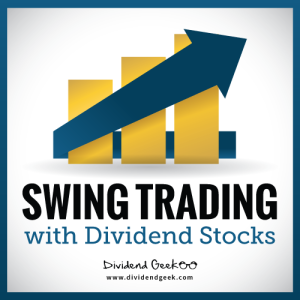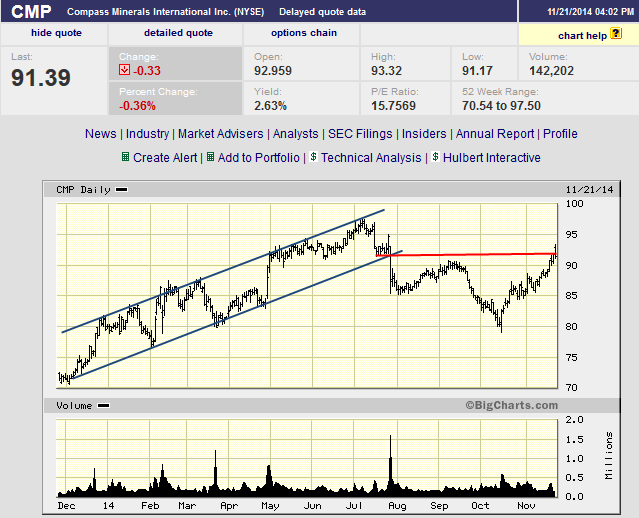Swing Trading – Part 2 Traditional vs Dividend Stocks
 In Part 1- Introduction (read it first if you missed it) I went over the basics of traditional swing trading and the possible benefits of using it with a small fraction of your capital.
In Part 1- Introduction (read it first if you missed it) I went over the basics of traditional swing trading and the possible benefits of using it with a small fraction of your capital.
In this post I’m going to explain the differences between traditional swing trading and my swing trading with dividend stocks system.
Traditional Swing Trading
In traditional swing trading systems a good trader will establish buy and sell rules that they strictly enforce. If their trade moves down instead of up they have a set amount they are willing to lose and quickly sell to cut their loses to a minimum. This type of in and out of the market may sound simple but it is extremely difficult. The market has a way of coming down momentarily to capture these small loss limit sell orders. A lot of small losses can add up both financially and psychologically. It is a lot of work (and time) to make a profit doing this as you have to find, and setup more new trades when they get taken out for a loss. More time then I have to dedicate. Traders that make money this way have paid the price to get where they are in terms of both time and money.
Swing Trading with Dividend Stocks
Now let’s take a look at how I utilize dividend stocks. Our system is similar in that we buy and sell within the stocks support and resistance trend lines. However, where the swing trading with dividend stocks system varies from these traditional trading systems is that instead of selling for a loss when our stock breaks through its support and forms a new trend we use high quality dividend paying stocks that we are okay with holding long-term and receive dividend payments while we wait to make our capital gain profit. It’s a two tier approach at any given time you can have an active block of money (or a trade) that is cycling up and down within support and resistance trend lines. This is what I call the active capital gains zone or upper zone where we are buying when the stock comes near the bottom of the channel (support) and then sell when the stock cycles or swings back up near the top of the channel (resistance).
You might say it is a combination or hybrid of short-term trading and long-term investing. There are several benefits that make this appealing to me being a first and foremost a long-term investor.
- The high quality sleep factor (and everyone know I like quality sleep) I don’t worry about my trades. If the the swing trade doesn’t work (drops below my buy price before moving back up to the resistance sell range) I now view it as another one of my great long term investments. I own a great company with competitive advantages that pays a nice dividend while I wait for it to come back up. (I’ll go over the watch list selection process in a future post.)
- I don’t have to sell for a loss. Granted I don’t make as much as the traditional swing trader, but I’m fine with the trade off because I’m not taking on as much risk.
- Helps with the whole psychological factor of getting whipped sawed out and taking losses.
- Takes less time – I don’t have to setup trades nearly as often, so it helps keeps this closer to a passive income system
To illustrate the active and inactive trading zones let’s take a look at the one year Compass Materials (CMP) chart. By the way CMP is a great long term dividend growth stock that we follow on Dividend Geek.
 For example there was an active trading zone (blue trend lines) from the beginning of the year to late July where several swing trades could have been placed at the bottom and top of this upward trending channel. However, if you bought again in late July at the bottom of the blue channel the trend broke and your swing trade would have moved below your buy price. Now your trade has moved into the inactive trading zone the area below your buy price (red line) where I hold it and treat it like a long term investment collecting the dividends. As you can see CMP has recently moved above the buy price and can be sold and used in a different trade that is a better swing trade prospect.
For example there was an active trading zone (blue trend lines) from the beginning of the year to late July where several swing trades could have been placed at the bottom and top of this upward trending channel. However, if you bought again in late July at the bottom of the blue channel the trend broke and your swing trade would have moved below your buy price. Now your trade has moved into the inactive trading zone the area below your buy price (red line) where I hold it and treat it like a long term investment collecting the dividends. As you can see CMP has recently moved above the buy price and can be sold and used in a different trade that is a better swing trade prospect.
In part 3 I’ll go over how to develop your swing trading watch list of dividend stocks.
Filed in: Swing Trading





Comments (1)
Trackback URL | Comments RSS Feed
Sites That Link to this Post